Business Communication Issues and Mitigation Strategies Report
VerifiedAdded on 2020/02/18
|14
|3709
|32
Report
AI Summary
This report examines effective business communication within a multinational agricultural equipment company facing internal and external communication challenges across five countries: Australia, India, Nigeria, Oman, and Vietnam. It analyzes the importance of the 7 Cs of communication (Completeness, Conciseness, Consideration, Clarity, Concreteness, Correctness, and Courtesy), formal communication methods, body language, documentation, and open communication within the organizational hierarchy as best practices. The report highlights the need for future strategies such as timely communication with clients, addressing communication breakdowns, gathering feedback, and adapting to local languages and cultural differences. It suggests forming a customer service team, encouraging open dialogue between management and employees, and respecting cultural diversity to improve overall communication effectiveness and business outcomes. The report emphasizes the importance of these strategies for improving client relationships and employee engagement.
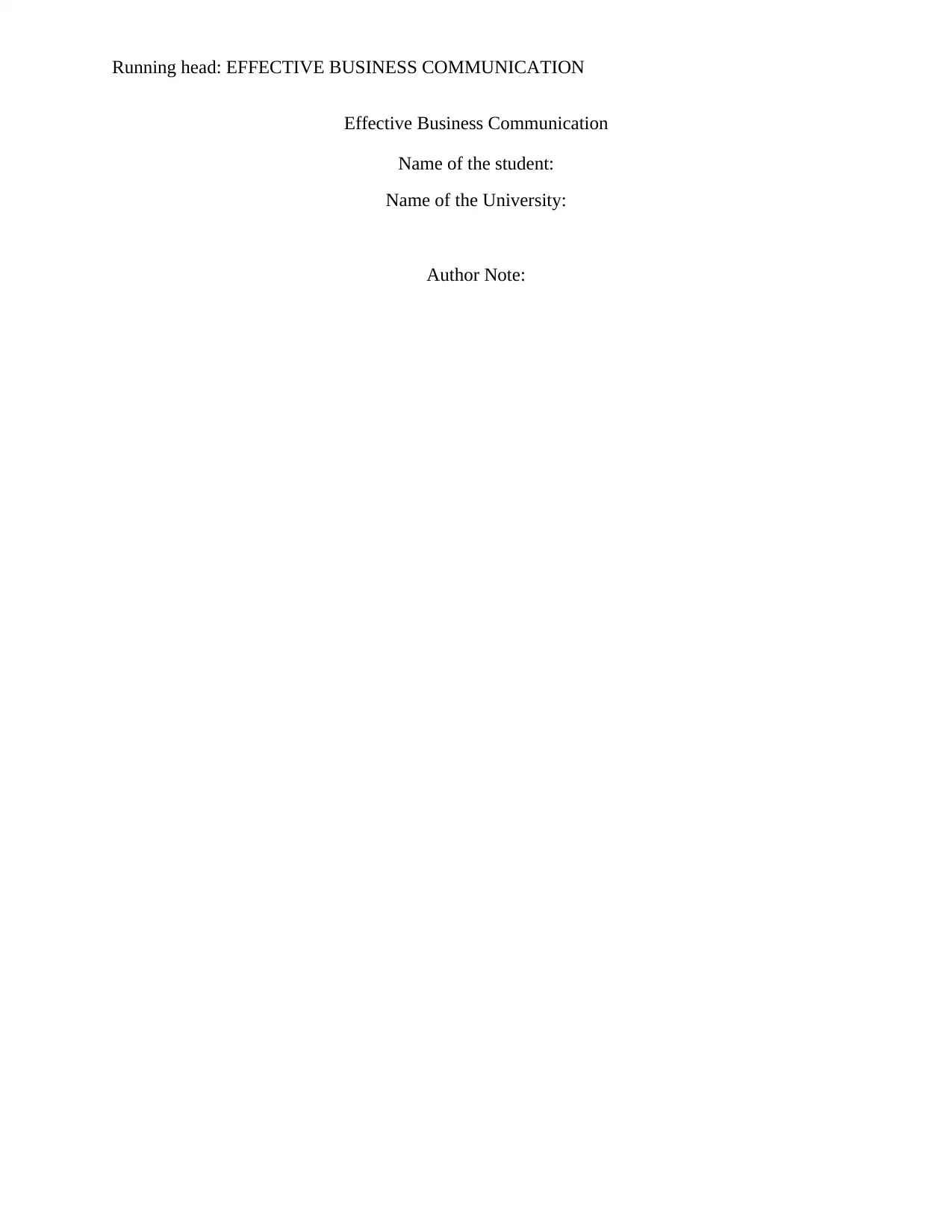
Running head: EFFECTIVE BUSINESS COMMUNICATION
Effective Business Communication
Name of the student:
Name of the University:
Author Note:
Effective Business Communication
Name of the student:
Name of the University:
Author Note:
Secure Best Marks with AI Grader
Need help grading? Try our AI Grader for instant feedback on your assignments.
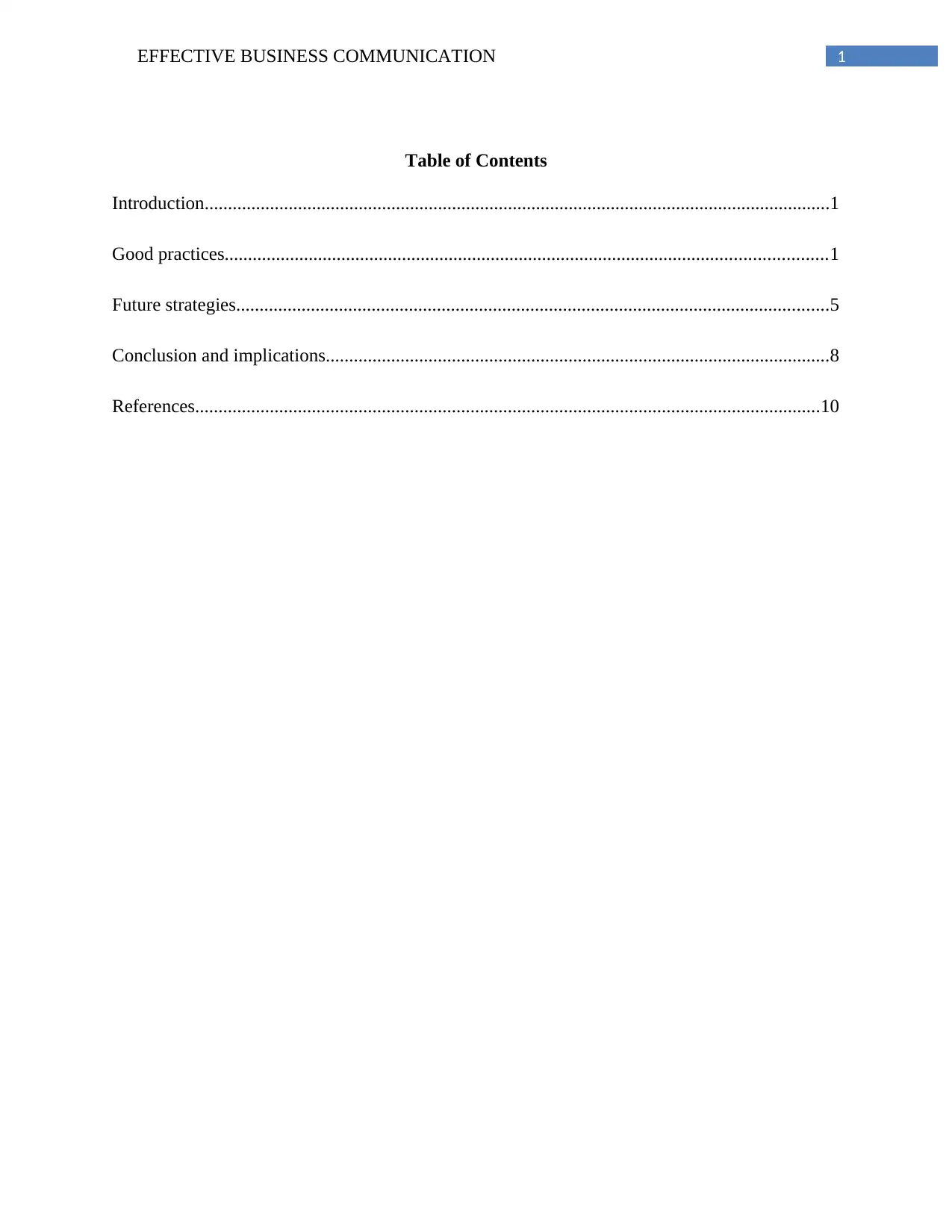
1EFFECTIVE BUSINESS COMMUNICATION
Table of Contents
Introduction......................................................................................................................................1
Good practices.................................................................................................................................1
Future strategies...............................................................................................................................5
Conclusion and implications............................................................................................................8
References......................................................................................................................................10
Table of Contents
Introduction......................................................................................................................................1
Good practices.................................................................................................................................1
Future strategies...............................................................................................................................5
Conclusion and implications............................................................................................................8
References......................................................................................................................................10
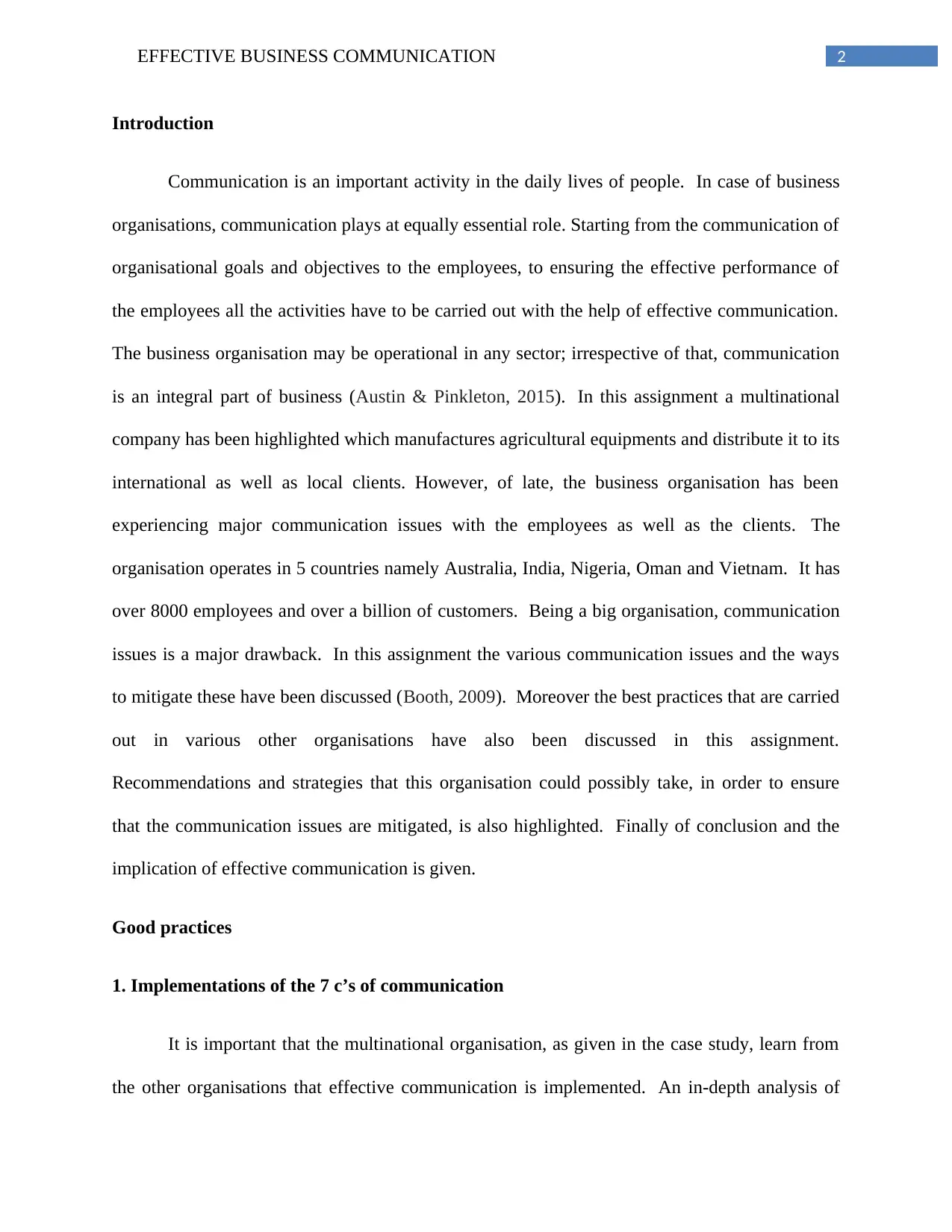
2EFFECTIVE BUSINESS COMMUNICATION
Introduction
Communication is an important activity in the daily lives of people. In case of business
organisations, communication plays at equally essential role. Starting from the communication of
organisational goals and objectives to the employees, to ensuring the effective performance of
the employees all the activities have to be carried out with the help of effective communication.
The business organisation may be operational in any sector; irrespective of that, communication
is an integral part of business (Austin & Pinkleton, 2015). In this assignment a multinational
company has been highlighted which manufactures agricultural equipments and distribute it to its
international as well as local clients. However, of late, the business organisation has been
experiencing major communication issues with the employees as well as the clients. The
organisation operates in 5 countries namely Australia, India, Nigeria, Oman and Vietnam. It has
over 8000 employees and over a billion of customers. Being a big organisation, communication
issues is a major drawback. In this assignment the various communication issues and the ways
to mitigate these have been discussed (Booth, 2009). Moreover the best practices that are carried
out in various other organisations have also been discussed in this assignment.
Recommendations and strategies that this organisation could possibly take, in order to ensure
that the communication issues are mitigated, is also highlighted. Finally of conclusion and the
implication of effective communication is given.
Good practices
1. Implementations of the 7 c’s of communication
It is important that the multinational organisation, as given in the case study, learn from
the other organisations that effective communication is implemented. An in-depth analysis of
Introduction
Communication is an important activity in the daily lives of people. In case of business
organisations, communication plays at equally essential role. Starting from the communication of
organisational goals and objectives to the employees, to ensuring the effective performance of
the employees all the activities have to be carried out with the help of effective communication.
The business organisation may be operational in any sector; irrespective of that, communication
is an integral part of business (Austin & Pinkleton, 2015). In this assignment a multinational
company has been highlighted which manufactures agricultural equipments and distribute it to its
international as well as local clients. However, of late, the business organisation has been
experiencing major communication issues with the employees as well as the clients. The
organisation operates in 5 countries namely Australia, India, Nigeria, Oman and Vietnam. It has
over 8000 employees and over a billion of customers. Being a big organisation, communication
issues is a major drawback. In this assignment the various communication issues and the ways
to mitigate these have been discussed (Booth, 2009). Moreover the best practices that are carried
out in various other organisations have also been discussed in this assignment.
Recommendations and strategies that this organisation could possibly take, in order to ensure
that the communication issues are mitigated, is also highlighted. Finally of conclusion and the
implication of effective communication is given.
Good practices
1. Implementations of the 7 c’s of communication
It is important that the multinational organisation, as given in the case study, learn from
the other organisations that effective communication is implemented. An in-depth analysis of
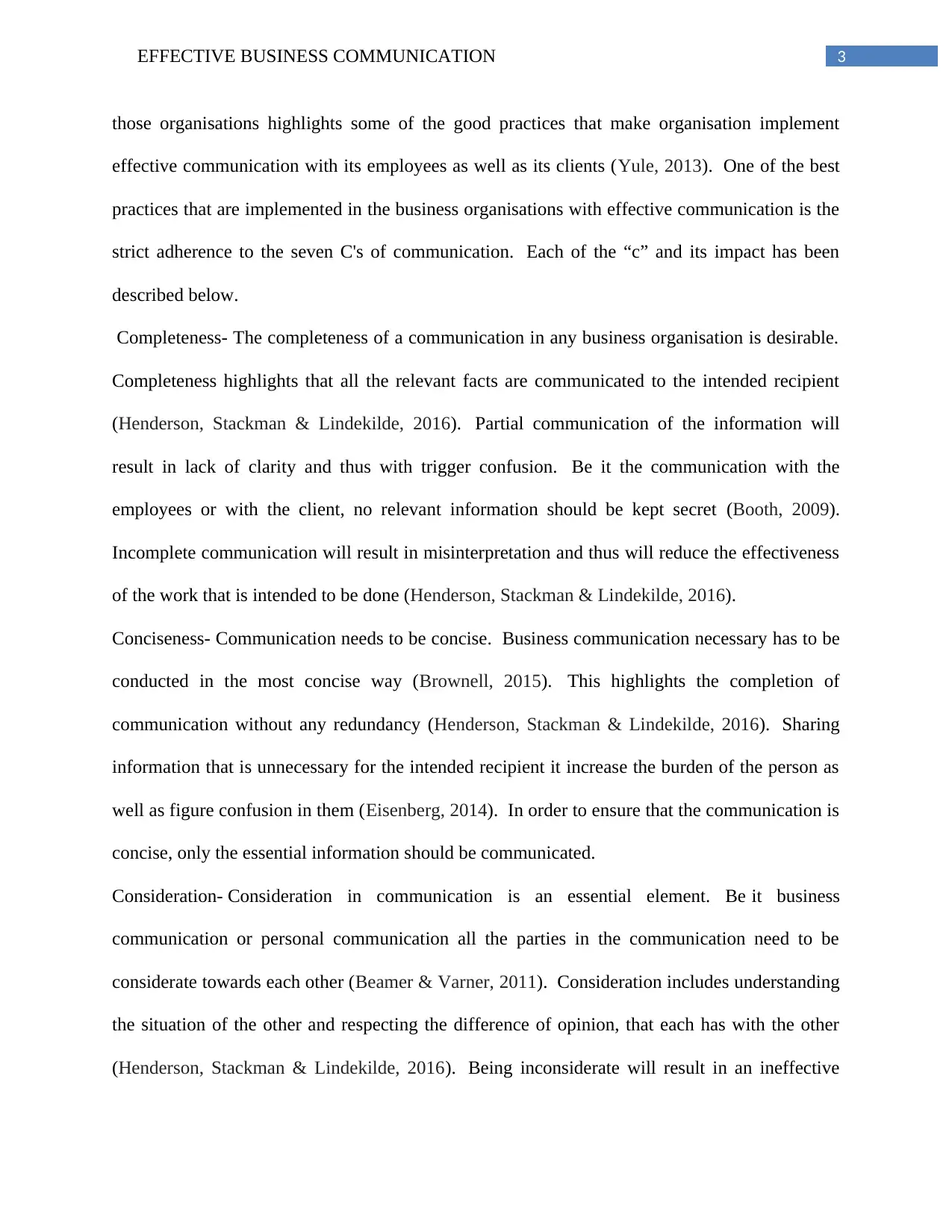
3EFFECTIVE BUSINESS COMMUNICATION
those organisations highlights some of the good practices that make organisation implement
effective communication with its employees as well as its clients (Yule, 2013). One of the best
practices that are implemented in the business organisations with effective communication is the
strict adherence to the seven C's of communication. Each of the “c” and its impact has been
described below.
Completeness- The completeness of a communication in any business organisation is desirable.
Completeness highlights that all the relevant facts are communicated to the intended recipient
(Henderson, Stackman & Lindekilde, 2016). Partial communication of the information will
result in lack of clarity and thus with trigger confusion. Be it the communication with the
employees or with the client, no relevant information should be kept secret (Booth, 2009).
Incomplete communication will result in misinterpretation and thus will reduce the effectiveness
of the work that is intended to be done (Henderson, Stackman & Lindekilde, 2016).
Conciseness- Communication needs to be concise. Business communication necessary has to be
conducted in the most concise way (Brownell, 2015). This highlights the completion of
communication without any redundancy (Henderson, Stackman & Lindekilde, 2016). Sharing
information that is unnecessary for the intended recipient it increase the burden of the person as
well as figure confusion in them (Eisenberg, 2014). In order to ensure that the communication is
concise, only the essential information should be communicated.
Consideration- Consideration in communication is an essential element. Be it business
communication or personal communication all the parties in the communication need to be
considerate towards each other (Beamer & Varner, 2011). Consideration includes understanding
the situation of the other and respecting the difference of opinion, that each has with the other
(Henderson, Stackman & Lindekilde, 2016). Being inconsiderate will result in an ineffective
those organisations highlights some of the good practices that make organisation implement
effective communication with its employees as well as its clients (Yule, 2013). One of the best
practices that are implemented in the business organisations with effective communication is the
strict adherence to the seven C's of communication. Each of the “c” and its impact has been
described below.
Completeness- The completeness of a communication in any business organisation is desirable.
Completeness highlights that all the relevant facts are communicated to the intended recipient
(Henderson, Stackman & Lindekilde, 2016). Partial communication of the information will
result in lack of clarity and thus with trigger confusion. Be it the communication with the
employees or with the client, no relevant information should be kept secret (Booth, 2009).
Incomplete communication will result in misinterpretation and thus will reduce the effectiveness
of the work that is intended to be done (Henderson, Stackman & Lindekilde, 2016).
Conciseness- Communication needs to be concise. Business communication necessary has to be
conducted in the most concise way (Brownell, 2015). This highlights the completion of
communication without any redundancy (Henderson, Stackman & Lindekilde, 2016). Sharing
information that is unnecessary for the intended recipient it increase the burden of the person as
well as figure confusion in them (Eisenberg, 2014). In order to ensure that the communication is
concise, only the essential information should be communicated.
Consideration- Consideration in communication is an essential element. Be it business
communication or personal communication all the parties in the communication need to be
considerate towards each other (Beamer & Varner, 2011). Consideration includes understanding
the situation of the other and respecting the difference of opinion, that each has with the other
(Henderson, Stackman & Lindekilde, 2016). Being inconsiderate will result in an ineffective
Secure Best Marks with AI Grader
Need help grading? Try our AI Grader for instant feedback on your assignments.
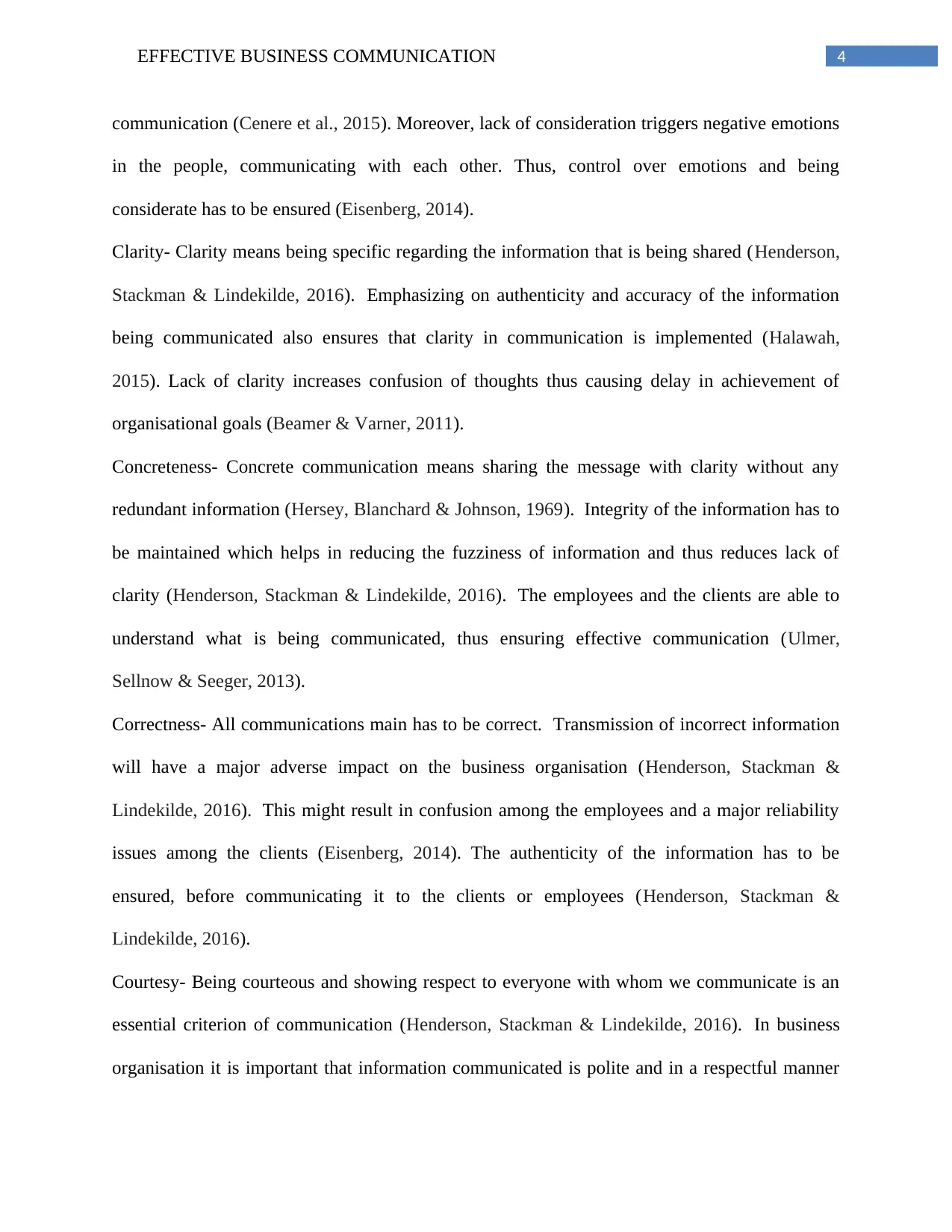
4EFFECTIVE BUSINESS COMMUNICATION
communication (Cenere et al., 2015). Moreover, lack of consideration triggers negative emotions
in the people, communicating with each other. Thus, control over emotions and being
considerate has to be ensured (Eisenberg, 2014).
Clarity- Clarity means being specific regarding the information that is being shared (Henderson,
Stackman & Lindekilde, 2016). Emphasizing on authenticity and accuracy of the information
being communicated also ensures that clarity in communication is implemented (Halawah,
2015). Lack of clarity increases confusion of thoughts thus causing delay in achievement of
organisational goals (Beamer & Varner, 2011).
Concreteness- Concrete communication means sharing the message with clarity without any
redundant information (Hersey, Blanchard & Johnson, 1969). Integrity of the information has to
be maintained which helps in reducing the fuzziness of information and thus reduces lack of
clarity (Henderson, Stackman & Lindekilde, 2016). The employees and the clients are able to
understand what is being communicated, thus ensuring effective communication (Ulmer,
Sellnow & Seeger, 2013).
Correctness- All communications main has to be correct. Transmission of incorrect information
will have a major adverse impact on the business organisation (Henderson, Stackman &
Lindekilde, 2016). This might result in confusion among the employees and a major reliability
issues among the clients (Eisenberg, 2014). The authenticity of the information has to be
ensured, before communicating it to the clients or employees (Henderson, Stackman &
Lindekilde, 2016).
Courtesy- Being courteous and showing respect to everyone with whom we communicate is an
essential criterion of communication (Henderson, Stackman & Lindekilde, 2016). In business
organisation it is important that information communicated is polite and in a respectful manner
communication (Cenere et al., 2015). Moreover, lack of consideration triggers negative emotions
in the people, communicating with each other. Thus, control over emotions and being
considerate has to be ensured (Eisenberg, 2014).
Clarity- Clarity means being specific regarding the information that is being shared (Henderson,
Stackman & Lindekilde, 2016). Emphasizing on authenticity and accuracy of the information
being communicated also ensures that clarity in communication is implemented (Halawah,
2015). Lack of clarity increases confusion of thoughts thus causing delay in achievement of
organisational goals (Beamer & Varner, 2011).
Concreteness- Concrete communication means sharing the message with clarity without any
redundant information (Hersey, Blanchard & Johnson, 1969). Integrity of the information has to
be maintained which helps in reducing the fuzziness of information and thus reduces lack of
clarity (Henderson, Stackman & Lindekilde, 2016). The employees and the clients are able to
understand what is being communicated, thus ensuring effective communication (Ulmer,
Sellnow & Seeger, 2013).
Correctness- All communications main has to be correct. Transmission of incorrect information
will have a major adverse impact on the business organisation (Henderson, Stackman &
Lindekilde, 2016). This might result in confusion among the employees and a major reliability
issues among the clients (Eisenberg, 2014). The authenticity of the information has to be
ensured, before communicating it to the clients or employees (Henderson, Stackman &
Lindekilde, 2016).
Courtesy- Being courteous and showing respect to everyone with whom we communicate is an
essential criterion of communication (Henderson, Stackman & Lindekilde, 2016). In business
organisation it is important that information communicated is polite and in a respectful manner
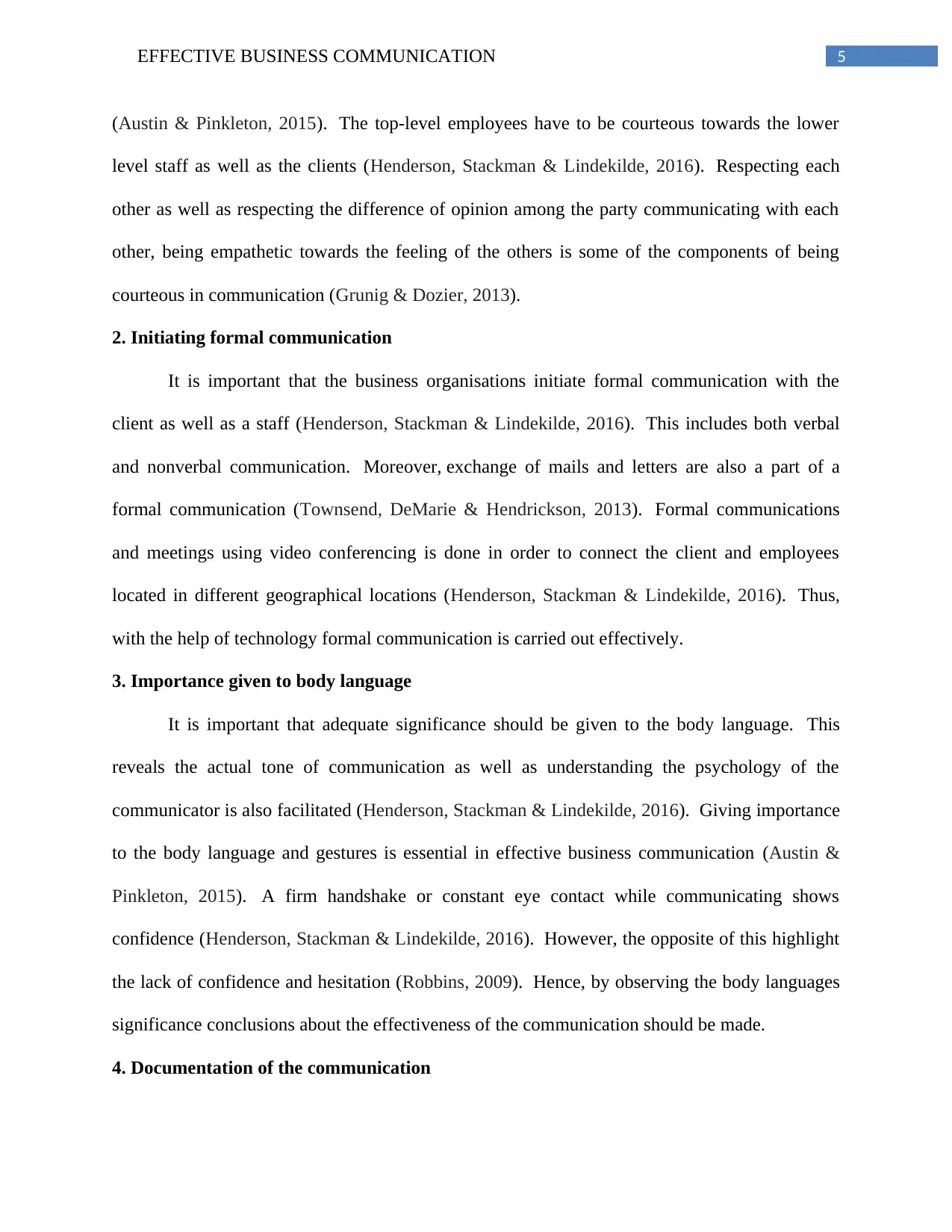
5EFFECTIVE BUSINESS COMMUNICATION
(Austin & Pinkleton, 2015). The top-level employees have to be courteous towards the lower
level staff as well as the clients (Henderson, Stackman & Lindekilde, 2016). Respecting each
other as well as respecting the difference of opinion among the party communicating with each
other, being empathetic towards the feeling of the others is some of the components of being
courteous in communication (Grunig & Dozier, 2013).
2. Initiating formal communication
It is important that the business organisations initiate formal communication with the
client as well as a staff (Henderson, Stackman & Lindekilde, 2016). This includes both verbal
and nonverbal communication. Moreover, exchange of mails and letters are also a part of a
formal communication (Townsend, DeMarie & Hendrickson, 2013). Formal communications
and meetings using video conferencing is done in order to connect the client and employees
located in different geographical locations (Henderson, Stackman & Lindekilde, 2016). Thus,
with the help of technology formal communication is carried out effectively.
3. Importance given to body language
It is important that adequate significance should be given to the body language. This
reveals the actual tone of communication as well as understanding the psychology of the
communicator is also facilitated (Henderson, Stackman & Lindekilde, 2016). Giving importance
to the body language and gestures is essential in effective business communication (Austin &
Pinkleton, 2015). A firm handshake or constant eye contact while communicating shows
confidence (Henderson, Stackman & Lindekilde, 2016). However, the opposite of this highlight
the lack of confidence and hesitation (Robbins, 2009). Hence, by observing the body languages
significance conclusions about the effectiveness of the communication should be made.
4. Documentation of the communication
(Austin & Pinkleton, 2015). The top-level employees have to be courteous towards the lower
level staff as well as the clients (Henderson, Stackman & Lindekilde, 2016). Respecting each
other as well as respecting the difference of opinion among the party communicating with each
other, being empathetic towards the feeling of the others is some of the components of being
courteous in communication (Grunig & Dozier, 2013).
2. Initiating formal communication
It is important that the business organisations initiate formal communication with the
client as well as a staff (Henderson, Stackman & Lindekilde, 2016). This includes both verbal
and nonverbal communication. Moreover, exchange of mails and letters are also a part of a
formal communication (Townsend, DeMarie & Hendrickson, 2013). Formal communications
and meetings using video conferencing is done in order to connect the client and employees
located in different geographical locations (Henderson, Stackman & Lindekilde, 2016). Thus,
with the help of technology formal communication is carried out effectively.
3. Importance given to body language
It is important that adequate significance should be given to the body language. This
reveals the actual tone of communication as well as understanding the psychology of the
communicator is also facilitated (Henderson, Stackman & Lindekilde, 2016). Giving importance
to the body language and gestures is essential in effective business communication (Austin &
Pinkleton, 2015). A firm handshake or constant eye contact while communicating shows
confidence (Henderson, Stackman & Lindekilde, 2016). However, the opposite of this highlight
the lack of confidence and hesitation (Robbins, 2009). Hence, by observing the body languages
significance conclusions about the effectiveness of the communication should be made.
4. Documentation of the communication
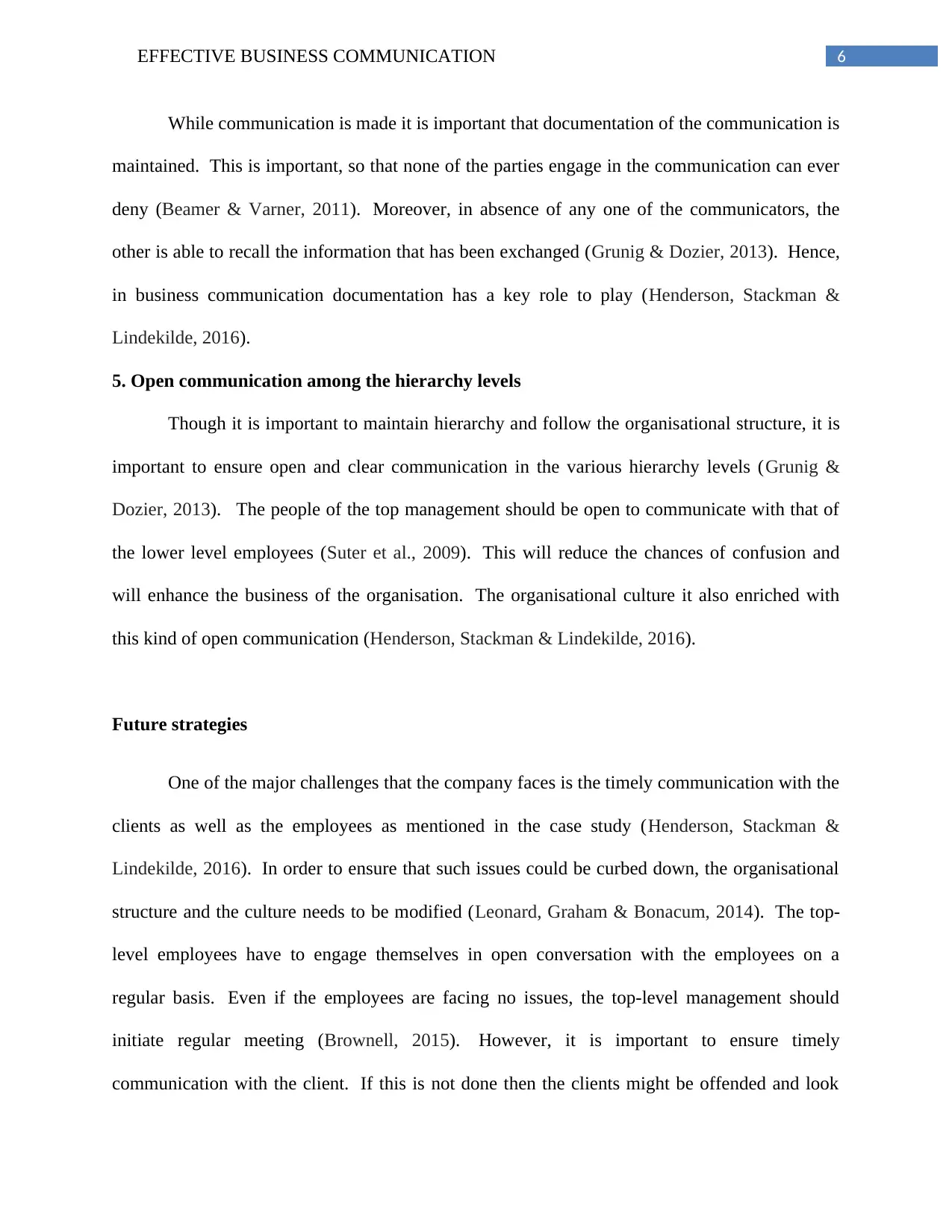
6EFFECTIVE BUSINESS COMMUNICATION
While communication is made it is important that documentation of the communication is
maintained. This is important, so that none of the parties engage in the communication can ever
deny (Beamer & Varner, 2011). Moreover, in absence of any one of the communicators, the
other is able to recall the information that has been exchanged (Grunig & Dozier, 2013). Hence,
in business communication documentation has a key role to play (Henderson, Stackman &
Lindekilde, 2016).
5. Open communication among the hierarchy levels
Though it is important to maintain hierarchy and follow the organisational structure, it is
important to ensure open and clear communication in the various hierarchy levels (Grunig &
Dozier, 2013). The people of the top management should be open to communicate with that of
the lower level employees (Suter et al., 2009). This will reduce the chances of confusion and
will enhance the business of the organisation. The organisational culture it also enriched with
this kind of open communication (Henderson, Stackman & Lindekilde, 2016).
Future strategies
One of the major challenges that the company faces is the timely communication with the
clients as well as the employees as mentioned in the case study (Henderson, Stackman &
Lindekilde, 2016). In order to ensure that such issues could be curbed down, the organisational
structure and the culture needs to be modified (Leonard, Graham & Bonacum, 2014). The top-
level employees have to engage themselves in open conversation with the employees on a
regular basis. Even if the employees are facing no issues, the top-level management should
initiate regular meeting (Brownell, 2015). However, it is important to ensure timely
communication with the client. If this is not done then the clients might be offended and look
While communication is made it is important that documentation of the communication is
maintained. This is important, so that none of the parties engage in the communication can ever
deny (Beamer & Varner, 2011). Moreover, in absence of any one of the communicators, the
other is able to recall the information that has been exchanged (Grunig & Dozier, 2013). Hence,
in business communication documentation has a key role to play (Henderson, Stackman &
Lindekilde, 2016).
5. Open communication among the hierarchy levels
Though it is important to maintain hierarchy and follow the organisational structure, it is
important to ensure open and clear communication in the various hierarchy levels (Grunig &
Dozier, 2013). The people of the top management should be open to communicate with that of
the lower level employees (Suter et al., 2009). This will reduce the chances of confusion and
will enhance the business of the organisation. The organisational culture it also enriched with
this kind of open communication (Henderson, Stackman & Lindekilde, 2016).
Future strategies
One of the major challenges that the company faces is the timely communication with the
clients as well as the employees as mentioned in the case study (Henderson, Stackman &
Lindekilde, 2016). In order to ensure that such issues could be curbed down, the organisational
structure and the culture needs to be modified (Leonard, Graham & Bonacum, 2014). The top-
level employees have to engage themselves in open conversation with the employees on a
regular basis. Even if the employees are facing no issues, the top-level management should
initiate regular meeting (Brownell, 2015). However, it is important to ensure timely
communication with the client. If this is not done then the clients might be offended and look
Paraphrase This Document
Need a fresh take? Get an instant paraphrase of this document with our AI Paraphraser
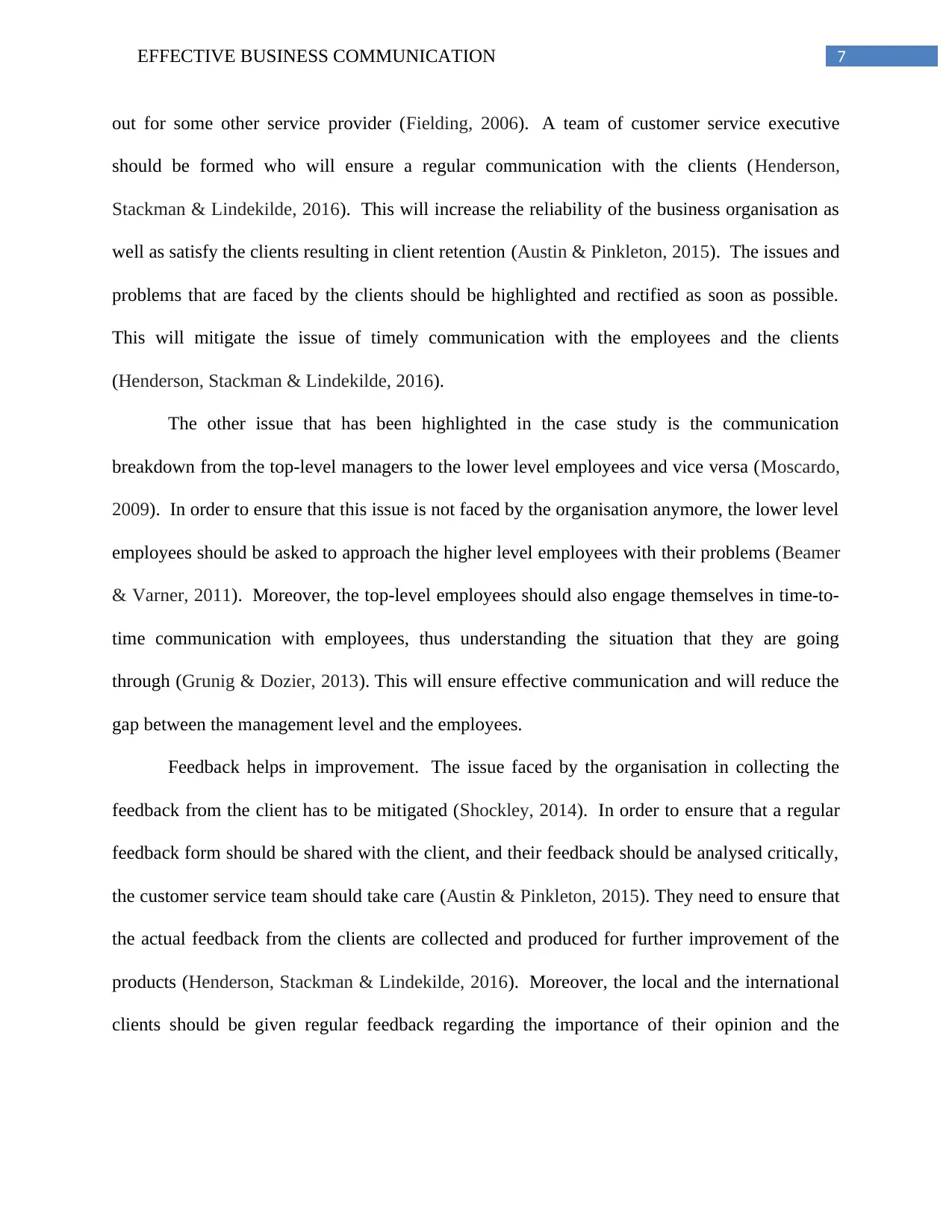
7EFFECTIVE BUSINESS COMMUNICATION
out for some other service provider (Fielding, 2006). A team of customer service executive
should be formed who will ensure a regular communication with the clients (Henderson,
Stackman & Lindekilde, 2016). This will increase the reliability of the business organisation as
well as satisfy the clients resulting in client retention (Austin & Pinkleton, 2015). The issues and
problems that are faced by the clients should be highlighted and rectified as soon as possible.
This will mitigate the issue of timely communication with the employees and the clients
(Henderson, Stackman & Lindekilde, 2016).
The other issue that has been highlighted in the case study is the communication
breakdown from the top-level managers to the lower level employees and vice versa (Moscardo,
2009). In order to ensure that this issue is not faced by the organisation anymore, the lower level
employees should be asked to approach the higher level employees with their problems (Beamer
& Varner, 2011). Moreover, the top-level employees should also engage themselves in time-to-
time communication with employees, thus understanding the situation that they are going
through (Grunig & Dozier, 2013). This will ensure effective communication and will reduce the
gap between the management level and the employees.
Feedback helps in improvement. The issue faced by the organisation in collecting the
feedback from the client has to be mitigated (Shockley, 2014). In order to ensure that a regular
feedback form should be shared with the client, and their feedback should be analysed critically,
the customer service team should take care (Austin & Pinkleton, 2015). They need to ensure that
the actual feedback from the clients are collected and produced for further improvement of the
products (Henderson, Stackman & Lindekilde, 2016). Moreover, the local and the international
clients should be given regular feedback regarding the importance of their opinion and the
out for some other service provider (Fielding, 2006). A team of customer service executive
should be formed who will ensure a regular communication with the clients (Henderson,
Stackman & Lindekilde, 2016). This will increase the reliability of the business organisation as
well as satisfy the clients resulting in client retention (Austin & Pinkleton, 2015). The issues and
problems that are faced by the clients should be highlighted and rectified as soon as possible.
This will mitigate the issue of timely communication with the employees and the clients
(Henderson, Stackman & Lindekilde, 2016).
The other issue that has been highlighted in the case study is the communication
breakdown from the top-level managers to the lower level employees and vice versa (Moscardo,
2009). In order to ensure that this issue is not faced by the organisation anymore, the lower level
employees should be asked to approach the higher level employees with their problems (Beamer
& Varner, 2011). Moreover, the top-level employees should also engage themselves in time-to-
time communication with employees, thus understanding the situation that they are going
through (Grunig & Dozier, 2013). This will ensure effective communication and will reduce the
gap between the management level and the employees.
Feedback helps in improvement. The issue faced by the organisation in collecting the
feedback from the client has to be mitigated (Shockley, 2014). In order to ensure that a regular
feedback form should be shared with the client, and their feedback should be analysed critically,
the customer service team should take care (Austin & Pinkleton, 2015). They need to ensure that
the actual feedback from the clients are collected and produced for further improvement of the
products (Henderson, Stackman & Lindekilde, 2016). Moreover, the local and the international
clients should be given regular feedback regarding the importance of their opinion and the
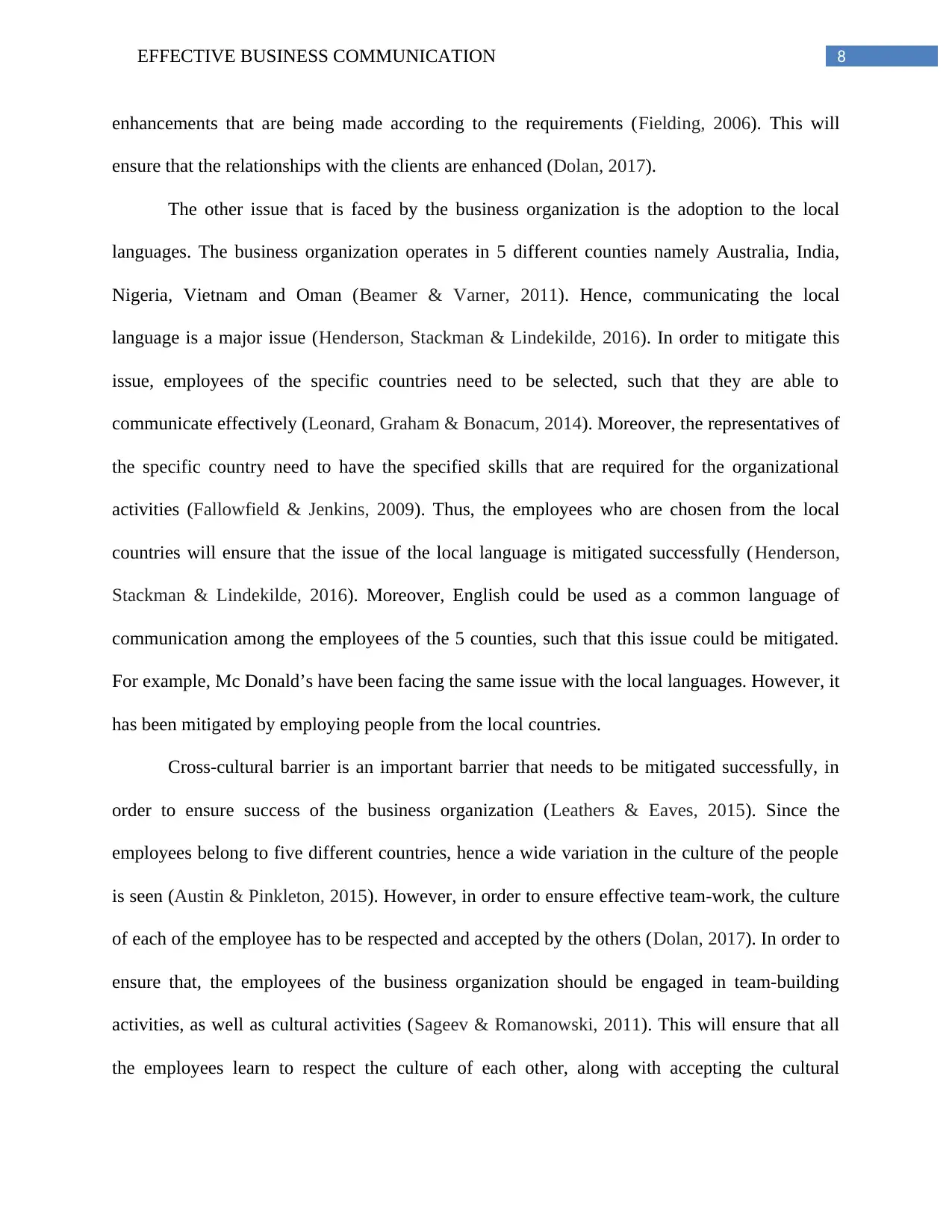
8EFFECTIVE BUSINESS COMMUNICATION
enhancements that are being made according to the requirements (Fielding, 2006). This will
ensure that the relationships with the clients are enhanced (Dolan, 2017).
The other issue that is faced by the business organization is the adoption to the local
languages. The business organization operates in 5 different counties namely Australia, India,
Nigeria, Vietnam and Oman (Beamer & Varner, 2011). Hence, communicating the local
language is a major issue (Henderson, Stackman & Lindekilde, 2016). In order to mitigate this
issue, employees of the specific countries need to be selected, such that they are able to
communicate effectively (Leonard, Graham & Bonacum, 2014). Moreover, the representatives of
the specific country need to have the specified skills that are required for the organizational
activities (Fallowfield & Jenkins, 2009). Thus, the employees who are chosen from the local
countries will ensure that the issue of the local language is mitigated successfully (Henderson,
Stackman & Lindekilde, 2016). Moreover, English could be used as a common language of
communication among the employees of the 5 counties, such that this issue could be mitigated.
For example, Mc Donald’s have been facing the same issue with the local languages. However, it
has been mitigated by employing people from the local countries.
Cross-cultural barrier is an important barrier that needs to be mitigated successfully, in
order to ensure success of the business organization (Leathers & Eaves, 2015). Since the
employees belong to five different countries, hence a wide variation in the culture of the people
is seen (Austin & Pinkleton, 2015). However, in order to ensure effective team-work, the culture
of each of the employee has to be respected and accepted by the others (Dolan, 2017). In order to
ensure that, the employees of the business organization should be engaged in team-building
activities, as well as cultural activities (Sageev & Romanowski, 2011). This will ensure that all
the employees learn to respect the culture of each other, along with accepting the cultural
enhancements that are being made according to the requirements (Fielding, 2006). This will
ensure that the relationships with the clients are enhanced (Dolan, 2017).
The other issue that is faced by the business organization is the adoption to the local
languages. The business organization operates in 5 different counties namely Australia, India,
Nigeria, Vietnam and Oman (Beamer & Varner, 2011). Hence, communicating the local
language is a major issue (Henderson, Stackman & Lindekilde, 2016). In order to mitigate this
issue, employees of the specific countries need to be selected, such that they are able to
communicate effectively (Leonard, Graham & Bonacum, 2014). Moreover, the representatives of
the specific country need to have the specified skills that are required for the organizational
activities (Fallowfield & Jenkins, 2009). Thus, the employees who are chosen from the local
countries will ensure that the issue of the local language is mitigated successfully (Henderson,
Stackman & Lindekilde, 2016). Moreover, English could be used as a common language of
communication among the employees of the 5 counties, such that this issue could be mitigated.
For example, Mc Donald’s have been facing the same issue with the local languages. However, it
has been mitigated by employing people from the local countries.
Cross-cultural barrier is an important barrier that needs to be mitigated successfully, in
order to ensure success of the business organization (Leathers & Eaves, 2015). Since the
employees belong to five different countries, hence a wide variation in the culture of the people
is seen (Austin & Pinkleton, 2015). However, in order to ensure effective team-work, the culture
of each of the employee has to be respected and accepted by the others (Dolan, 2017). In order to
ensure that, the employees of the business organization should be engaged in team-building
activities, as well as cultural activities (Sageev & Romanowski, 2011). This will ensure that all
the employees learn to respect the culture of each other, along with accepting the cultural
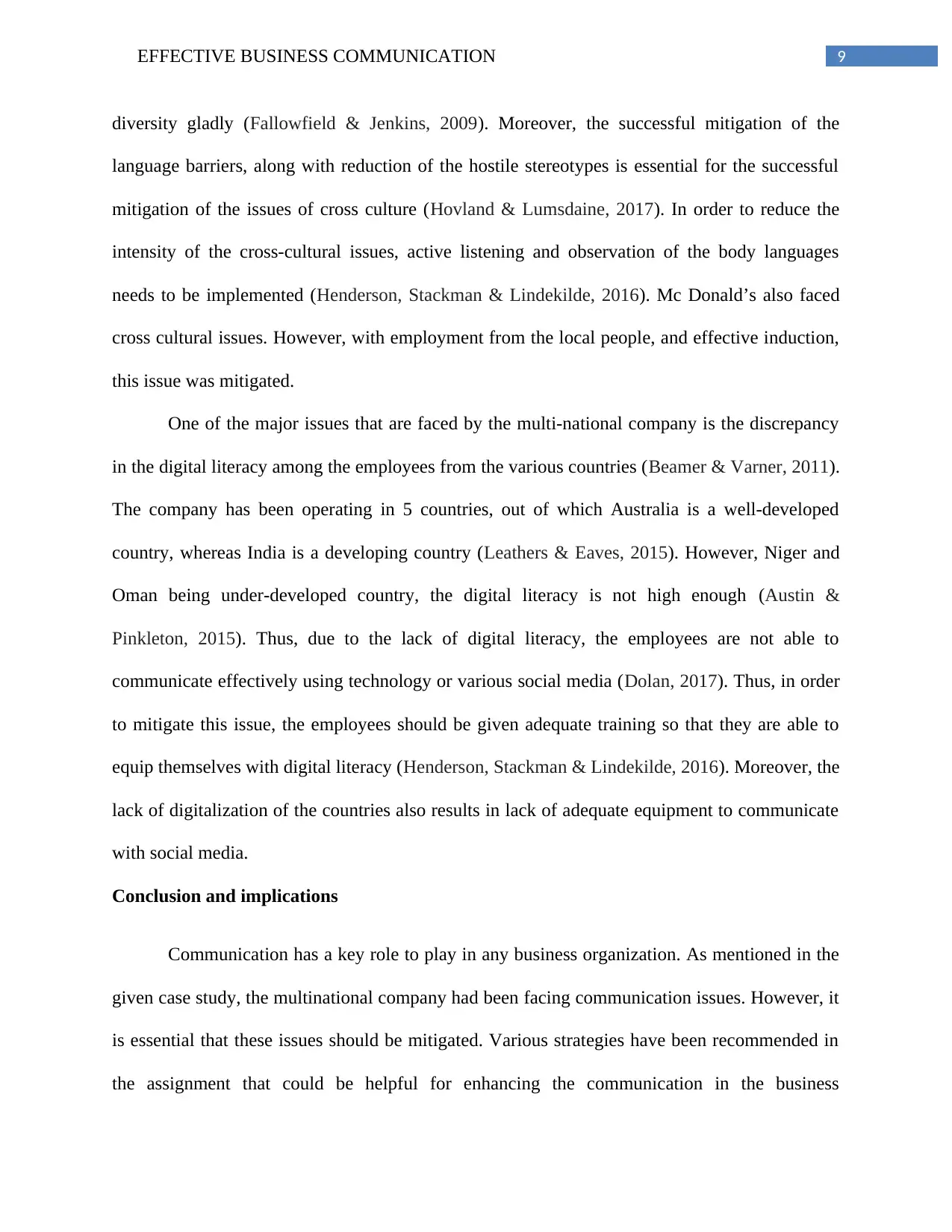
9EFFECTIVE BUSINESS COMMUNICATION
diversity gladly (Fallowfield & Jenkins, 2009). Moreover, the successful mitigation of the
language barriers, along with reduction of the hostile stereotypes is essential for the successful
mitigation of the issues of cross culture (Hovland & Lumsdaine, 2017). In order to reduce the
intensity of the cross-cultural issues, active listening and observation of the body languages
needs to be implemented (Henderson, Stackman & Lindekilde, 2016). Mc Donald’s also faced
cross cultural issues. However, with employment from the local people, and effective induction,
this issue was mitigated.
One of the major issues that are faced by the multi-national company is the discrepancy
in the digital literacy among the employees from the various countries (Beamer & Varner, 2011).
The company has been operating in 5 countries, out of which Australia is a well-developed
country, whereas India is a developing country (Leathers & Eaves, 2015). However, Niger and
Oman being under-developed country, the digital literacy is not high enough (Austin &
Pinkleton, 2015). Thus, due to the lack of digital literacy, the employees are not able to
communicate effectively using technology or various social media (Dolan, 2017). Thus, in order
to mitigate this issue, the employees should be given adequate training so that they are able to
equip themselves with digital literacy (Henderson, Stackman & Lindekilde, 2016). Moreover, the
lack of digitalization of the countries also results in lack of adequate equipment to communicate
with social media.
Conclusion and implications
Communication has a key role to play in any business organization. As mentioned in the
given case study, the multinational company had been facing communication issues. However, it
is essential that these issues should be mitigated. Various strategies have been recommended in
the assignment that could be helpful for enhancing the communication in the business
diversity gladly (Fallowfield & Jenkins, 2009). Moreover, the successful mitigation of the
language barriers, along with reduction of the hostile stereotypes is essential for the successful
mitigation of the issues of cross culture (Hovland & Lumsdaine, 2017). In order to reduce the
intensity of the cross-cultural issues, active listening and observation of the body languages
needs to be implemented (Henderson, Stackman & Lindekilde, 2016). Mc Donald’s also faced
cross cultural issues. However, with employment from the local people, and effective induction,
this issue was mitigated.
One of the major issues that are faced by the multi-national company is the discrepancy
in the digital literacy among the employees from the various countries (Beamer & Varner, 2011).
The company has been operating in 5 countries, out of which Australia is a well-developed
country, whereas India is a developing country (Leathers & Eaves, 2015). However, Niger and
Oman being under-developed country, the digital literacy is not high enough (Austin &
Pinkleton, 2015). Thus, due to the lack of digital literacy, the employees are not able to
communicate effectively using technology or various social media (Dolan, 2017). Thus, in order
to mitigate this issue, the employees should be given adequate training so that they are able to
equip themselves with digital literacy (Henderson, Stackman & Lindekilde, 2016). Moreover, the
lack of digitalization of the countries also results in lack of adequate equipment to communicate
with social media.
Conclusion and implications
Communication has a key role to play in any business organization. As mentioned in the
given case study, the multinational company had been facing communication issues. However, it
is essential that these issues should be mitigated. Various strategies have been recommended in
the assignment that could be helpful for enhancing the communication in the business
Secure Best Marks with AI Grader
Need help grading? Try our AI Grader for instant feedback on your assignments.
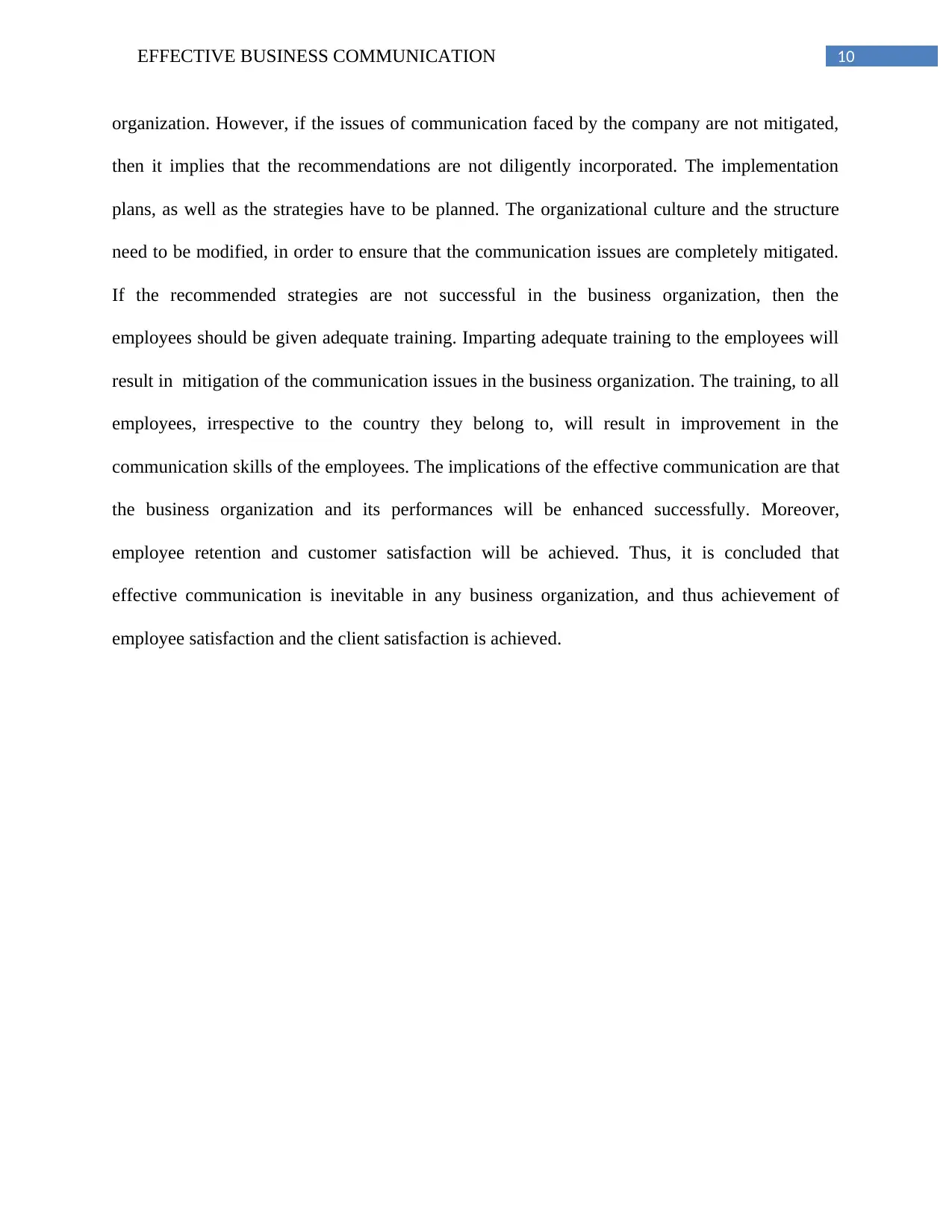
10EFFECTIVE BUSINESS COMMUNICATION
organization. However, if the issues of communication faced by the company are not mitigated,
then it implies that the recommendations are not diligently incorporated. The implementation
plans, as well as the strategies have to be planned. The organizational culture and the structure
need to be modified, in order to ensure that the communication issues are completely mitigated.
If the recommended strategies are not successful in the business organization, then the
employees should be given adequate training. Imparting adequate training to the employees will
result in mitigation of the communication issues in the business organization. The training, to all
employees, irrespective to the country they belong to, will result in improvement in the
communication skills of the employees. The implications of the effective communication are that
the business organization and its performances will be enhanced successfully. Moreover,
employee retention and customer satisfaction will be achieved. Thus, it is concluded that
effective communication is inevitable in any business organization, and thus achievement of
employee satisfaction and the client satisfaction is achieved.
organization. However, if the issues of communication faced by the company are not mitigated,
then it implies that the recommendations are not diligently incorporated. The implementation
plans, as well as the strategies have to be planned. The organizational culture and the structure
need to be modified, in order to ensure that the communication issues are completely mitigated.
If the recommended strategies are not successful in the business organization, then the
employees should be given adequate training. Imparting adequate training to the employees will
result in mitigation of the communication issues in the business organization. The training, to all
employees, irrespective to the country they belong to, will result in improvement in the
communication skills of the employees. The implications of the effective communication are that
the business organization and its performances will be enhanced successfully. Moreover,
employee retention and customer satisfaction will be achieved. Thus, it is concluded that
effective communication is inevitable in any business organization, and thus achievement of
employee satisfaction and the client satisfaction is achieved.
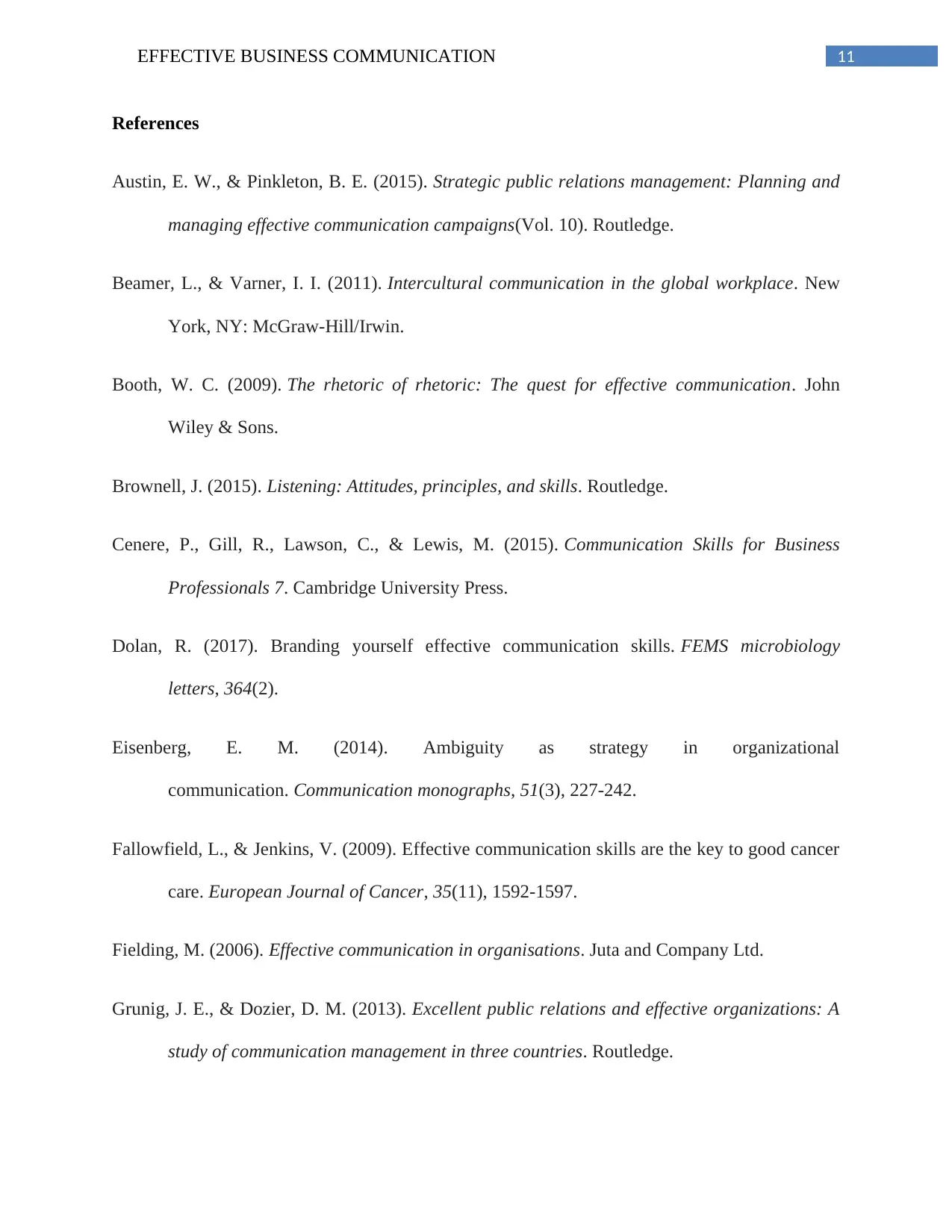
11EFFECTIVE BUSINESS COMMUNICATION
References
Austin, E. W., & Pinkleton, B. E. (2015). Strategic public relations management: Planning and
managing effective communication campaigns(Vol. 10). Routledge.
Beamer, L., & Varner, I. I. (2011). Intercultural communication in the global workplace. New
York, NY: McGraw-Hill/Irwin.
Booth, W. C. (2009). The rhetoric of rhetoric: The quest for effective communication. John
Wiley & Sons.
Brownell, J. (2015). Listening: Attitudes, principles, and skills. Routledge.
Cenere, P., Gill, R., Lawson, C., & Lewis, M. (2015). Communication Skills for Business
Professionals 7. Cambridge University Press.
Dolan, R. (2017). Branding yourself effective communication skills. FEMS microbiology
letters, 364(2).
Eisenberg, E. M. (2014). Ambiguity as strategy in organizational
communication. Communication monographs, 51(3), 227-242.
Fallowfield, L., & Jenkins, V. (2009). Effective communication skills are the key to good cancer
care. European Journal of Cancer, 35(11), 1592-1597.
Fielding, M. (2006). Effective communication in organisations. Juta and Company Ltd.
Grunig, J. E., & Dozier, D. M. (2013). Excellent public relations and effective organizations: A
study of communication management in three countries. Routledge.
References
Austin, E. W., & Pinkleton, B. E. (2015). Strategic public relations management: Planning and
managing effective communication campaigns(Vol. 10). Routledge.
Beamer, L., & Varner, I. I. (2011). Intercultural communication in the global workplace. New
York, NY: McGraw-Hill/Irwin.
Booth, W. C. (2009). The rhetoric of rhetoric: The quest for effective communication. John
Wiley & Sons.
Brownell, J. (2015). Listening: Attitudes, principles, and skills. Routledge.
Cenere, P., Gill, R., Lawson, C., & Lewis, M. (2015). Communication Skills for Business
Professionals 7. Cambridge University Press.
Dolan, R. (2017). Branding yourself effective communication skills. FEMS microbiology
letters, 364(2).
Eisenberg, E. M. (2014). Ambiguity as strategy in organizational
communication. Communication monographs, 51(3), 227-242.
Fallowfield, L., & Jenkins, V. (2009). Effective communication skills are the key to good cancer
care. European Journal of Cancer, 35(11), 1592-1597.
Fielding, M. (2006). Effective communication in organisations. Juta and Company Ltd.
Grunig, J. E., & Dozier, D. M. (2013). Excellent public relations and effective organizations: A
study of communication management in three countries. Routledge.
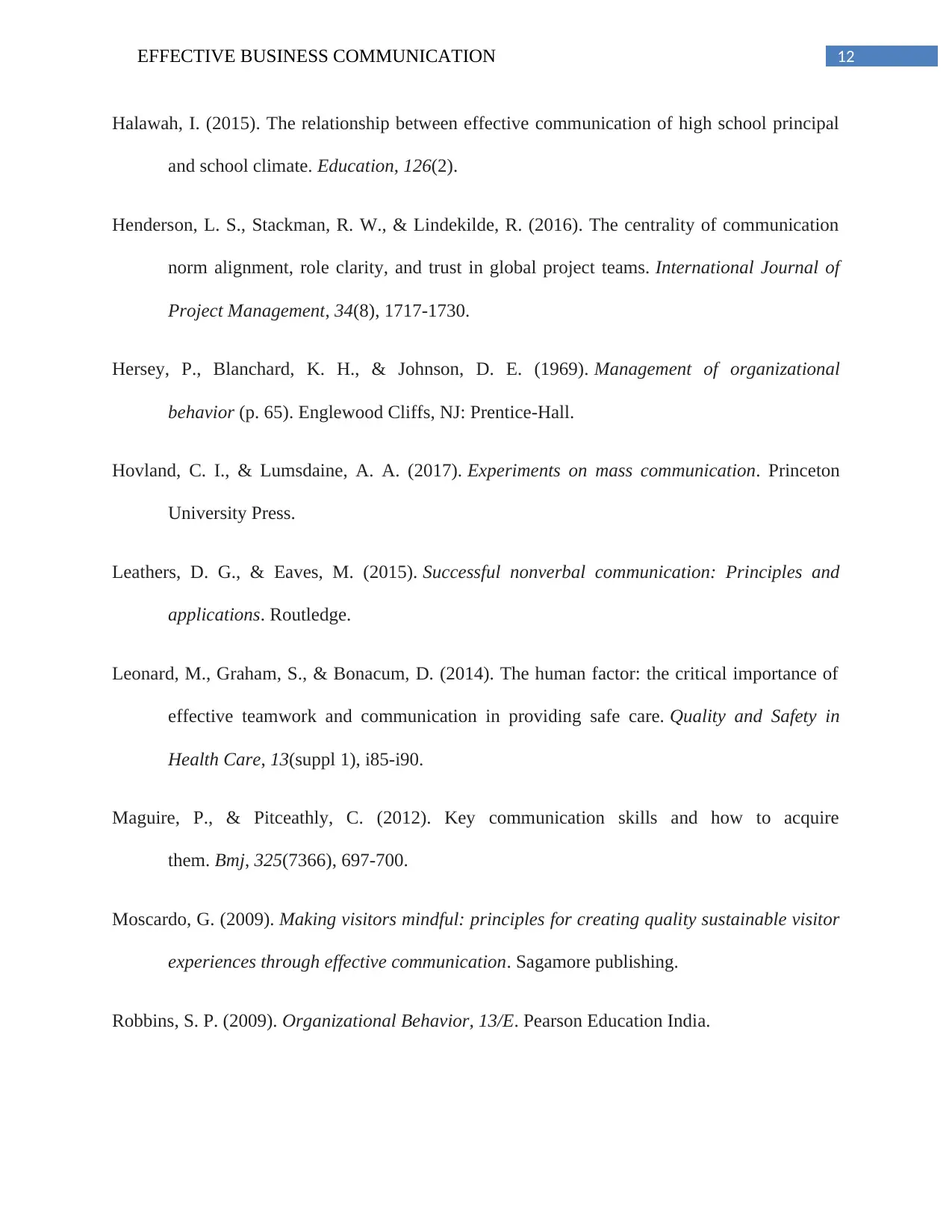
12EFFECTIVE BUSINESS COMMUNICATION
Halawah, I. (2015). The relationship between effective communication of high school principal
and school climate. Education, 126(2).
Henderson, L. S., Stackman, R. W., & Lindekilde, R. (2016). The centrality of communication
norm alignment, role clarity, and trust in global project teams. International Journal of
Project Management, 34(8), 1717-1730.
Hersey, P., Blanchard, K. H., & Johnson, D. E. (1969). Management of organizational
behavior (p. 65). Englewood Cliffs, NJ: Prentice-Hall.
Hovland, C. I., & Lumsdaine, A. A. (2017). Experiments on mass communication. Princeton
University Press.
Leathers, D. G., & Eaves, M. (2015). Successful nonverbal communication: Principles and
applications. Routledge.
Leonard, M., Graham, S., & Bonacum, D. (2014). The human factor: the critical importance of
effective teamwork and communication in providing safe care. Quality and Safety in
Health Care, 13(suppl 1), i85-i90.
Maguire, P., & Pitceathly, C. (2012). Key communication skills and how to acquire
them. Bmj, 325(7366), 697-700.
Moscardo, G. (2009). Making visitors mindful: principles for creating quality sustainable visitor
experiences through effective communication. Sagamore publishing.
Robbins, S. P. (2009). Organizational Behavior, 13/E. Pearson Education India.
Halawah, I. (2015). The relationship between effective communication of high school principal
and school climate. Education, 126(2).
Henderson, L. S., Stackman, R. W., & Lindekilde, R. (2016). The centrality of communication
norm alignment, role clarity, and trust in global project teams. International Journal of
Project Management, 34(8), 1717-1730.
Hersey, P., Blanchard, K. H., & Johnson, D. E. (1969). Management of organizational
behavior (p. 65). Englewood Cliffs, NJ: Prentice-Hall.
Hovland, C. I., & Lumsdaine, A. A. (2017). Experiments on mass communication. Princeton
University Press.
Leathers, D. G., & Eaves, M. (2015). Successful nonverbal communication: Principles and
applications. Routledge.
Leonard, M., Graham, S., & Bonacum, D. (2014). The human factor: the critical importance of
effective teamwork and communication in providing safe care. Quality and Safety in
Health Care, 13(suppl 1), i85-i90.
Maguire, P., & Pitceathly, C. (2012). Key communication skills and how to acquire
them. Bmj, 325(7366), 697-700.
Moscardo, G. (2009). Making visitors mindful: principles for creating quality sustainable visitor
experiences through effective communication. Sagamore publishing.
Robbins, S. P. (2009). Organizational Behavior, 13/E. Pearson Education India.
Paraphrase This Document
Need a fresh take? Get an instant paraphrase of this document with our AI Paraphraser
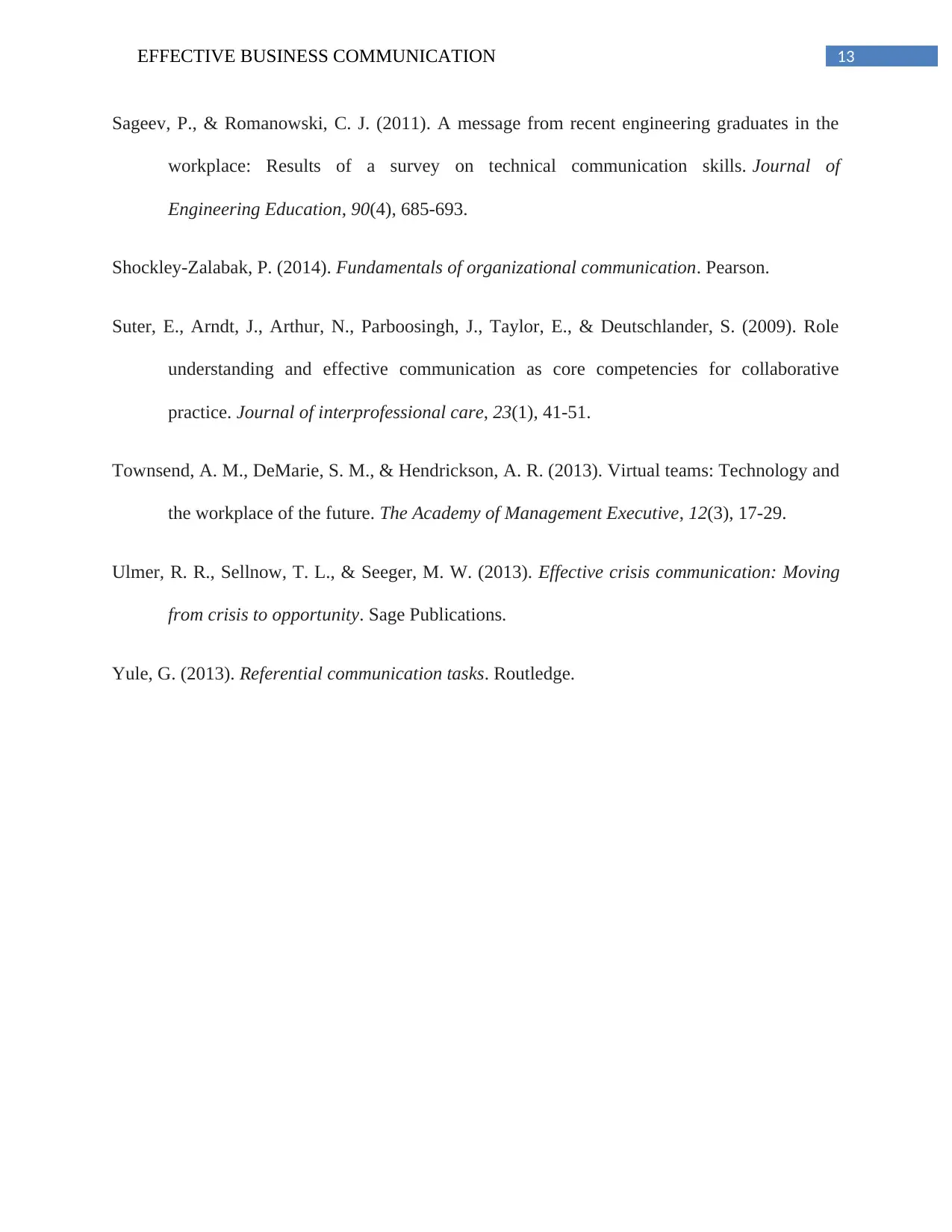
13EFFECTIVE BUSINESS COMMUNICATION
Sageev, P., & Romanowski, C. J. (2011). A message from recent engineering graduates in the
workplace: Results of a survey on technical communication skills. Journal of
Engineering Education, 90(4), 685-693.
Shockley-Zalabak, P. (2014). Fundamentals of organizational communication. Pearson.
Suter, E., Arndt, J., Arthur, N., Parboosingh, J., Taylor, E., & Deutschlander, S. (2009). Role
understanding and effective communication as core competencies for collaborative
practice. Journal of interprofessional care, 23(1), 41-51.
Townsend, A. M., DeMarie, S. M., & Hendrickson, A. R. (2013). Virtual teams: Technology and
the workplace of the future. The Academy of Management Executive, 12(3), 17-29.
Ulmer, R. R., Sellnow, T. L., & Seeger, M. W. (2013). Effective crisis communication: Moving
from crisis to opportunity. Sage Publications.
Yule, G. (2013). Referential communication tasks. Routledge.
Sageev, P., & Romanowski, C. J. (2011). A message from recent engineering graduates in the
workplace: Results of a survey on technical communication skills. Journal of
Engineering Education, 90(4), 685-693.
Shockley-Zalabak, P. (2014). Fundamentals of organizational communication. Pearson.
Suter, E., Arndt, J., Arthur, N., Parboosingh, J., Taylor, E., & Deutschlander, S. (2009). Role
understanding and effective communication as core competencies for collaborative
practice. Journal of interprofessional care, 23(1), 41-51.
Townsend, A. M., DeMarie, S. M., & Hendrickson, A. R. (2013). Virtual teams: Technology and
the workplace of the future. The Academy of Management Executive, 12(3), 17-29.
Ulmer, R. R., Sellnow, T. L., & Seeger, M. W. (2013). Effective crisis communication: Moving
from crisis to opportunity. Sage Publications.
Yule, G. (2013). Referential communication tasks. Routledge.
1 out of 14
Related Documents
Your All-in-One AI-Powered Toolkit for Academic Success.
+13062052269
info@desklib.com
Available 24*7 on WhatsApp / Email
![[object Object]](/_next/static/media/star-bottom.7253800d.svg)
Unlock your academic potential
© 2024 | Zucol Services PVT LTD | All rights reserved.





